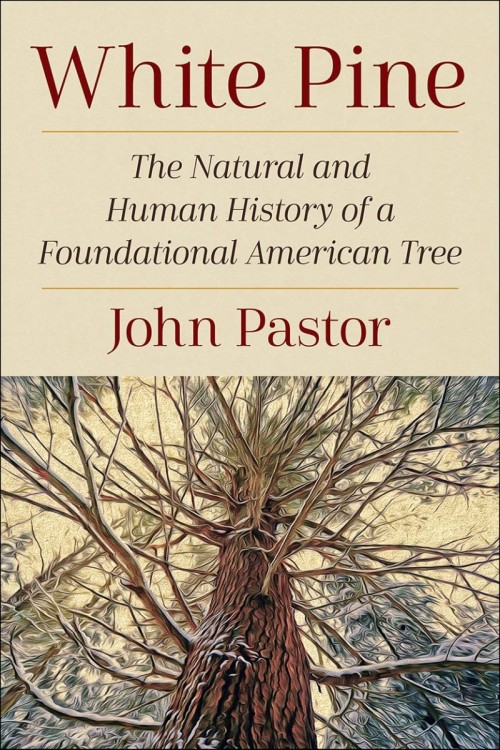by John Pastor
Island Press, 2023
Many years ago, I visited a small stand of virgin white pine older than the Declaration of Independence in Bradford, New Hampshire, not far from the Warner River: 20 or so trees much more than 100 feet tall, 3 feet in diameter at breast height. Some sported lightning rods. All towered above the accompanying hemlocks, prodigious themselves. Inside the woods, sunlight was scarce, and the few pine saplings that found a modicum of filtered light died long before they reached the canopy.
White Pine: The Natural and Human History of a Foundational American Tree, by John Pastor, celebrates the tree, the bedrock of northeastern natural history, the economic scaffolding of a fledgling nation. The North Woods once darkened more than 100,000 square miles and supported an estimated 6 billion board feet of white pine. In the nineteenth century alone, the milling of white pine added more than $4 billion to the U.S. economy, more than three times the income generated from the California Gold Rush.
Pastor’s story is extensive and excellent. The oldest known pine tree, Pinus mundayi, appeared during the early Cretaceous, 130 million years ago, in what is now Nova Scotia. Pine trees spread across lands destined to become Eurasia and North America but still remain absent from the Southern Hemisphere. The charred fossil twigs of P. mundayi suggest it suffered fire, perhaps fueled by its own resins. Pine trees, as Pastor notes, have been associated with wildfire from the beginning.
While white pine is considered family in traditional Algonquian culture, providing for the animals that provide for people, from the perspective of European colonists, it was a short-term cash cow. White pine was everywhere and large; the wood light, white, straight, and durable. North America’s first sawmill appeared in 1623 in York, Maine, and a single pine suitable for a ship’s mast sold for upward of $16,000 in today’s currency. By the latter half of the nineteenth century, the relentless harvest of pine led to the near collapse of an ecosystem.
Pastor’s history also profiles the tree’s champions, among them Henry David Thoreau, George Perkins Marsh, Gifford Pinchot, and Sanford Gifford, a member of the Hudson River School. The new interest in scientific forest management, writes Pastor, encouraged, “a willingness to defer profits for decades while investing in the care of younger trees.” But there’s irony in the story of early efforts to restore white pine. By the early 1900s, American foresters and nurserymen began importing millions of seedlings from France and Germany, descendants of American pines exported to Europe for timber production. Along with European seedlings came pine blister rust, a fungal disease native to European pines, which attacks five-needle pines (white) but not two-needle pines (Jack and red). The rust’s intermediate hosts, gooseberry and currant, grow liberally in eastern North America.
Pastor also writes about Franklin Roosevelt’s tree army – the Depression-era Civilian Conservation Corps, who planted millions of white pine seedlings – and he notes the remarkable recent discoveries about white pine’s interactions with other species. White pine seedlings growing in full sun in infertile soil have a symbiotic relationship with mycorrhizal soil fungi, which aid in nitrogen and phosphorus uptake. One species of fungus kills springtails; the tiny hexapods provide up to 25 percent of the pines’ nutrient uptake. The fruiting bodies of the fungi are eaten by red-backed voles, which disperse the spores in their fecal pellets. And voles depend on downed, rotting pine trees for shelter – a vital three-way alliance.
Had I read Pastor’s book before I visited the Bradford pines, more than the size of the trees would have awed me.


